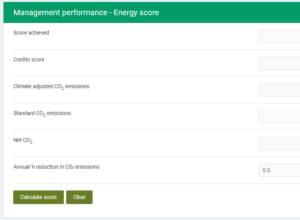Ene 24 methodology - KBCN1613
This issue is scored based on % improvement relative to the
BIU V6 carbon benchmark and average annual improvement across the reporting periods.
[accordion]
[accordion_block title="BIU V6 carbon benchmark"]
 Standard CO2 emissions:
Standard CO2 emissions: the tailored benchmark of a UK asset.
Climate adjusted CO2 emissions: the benchmark for International assets. It adjusts the UK benchmark to account for national and regional differences.
Net CO2: the actual CO2 emissions of the asset.
Annual reduction in CO2 emissions: the annual average % figure used to score credits in Ene 24.
[/accordion_block]
[/accordion]
Example scenario
An international BIU asset calculates the improvement in CO2 emissions across 2 reporting periods.
- CO2 emissions benchmark = 50 kgCO2e/m2 per year.
- 01-Jan-2020 to 31-Dec-2020.
CO2e emissions are 90 kgCO2e/m2 per year (1.8x the benchmark).
- 01-Jan-2023 to 31-Dec-2023.
CO2e emissions are 60 kgCO2e/m2 per year (1.2x the benchmark).
- Time between reporting periods: 3.0 years.
Calculation
- Improvement over 3 years = 1.8 - 1.2 = 0.6x improvement vs benchmark.
- 0.6 = 60%
- 60% / 3.0 years = 20%
The asset demonstrates a 20% average annual improvement vs the benchmark. It scores 3 exemplary credits.
How the calculation accounts for different reporting periods
Most assessments will report on multiple fuels in each period.
- Individual reporting periods for fuels may not align.
- Reporting periods may not begin or end at the same time each year.
[accordion]
[accordion_block title = "Calculating time between reporting periods"]
Time between reporting periods is measured in days (this is converted to years in the final calculation). Time is measured from the middle of each reporting period.
If more than one fuel is reported, the individual mid-dates for each fuel are combined through a weighting calculation. The mid-date is proportionally weighted towards fuels with larger associated CO2 emissions.

[/accordion_block]
[accordion_block title = "Maximum time between reporting periods"]
The maximum time between any reporting period is 1460 days (3 years 364 days) between:
- The first recorded consumption data in the 1st period, and
- The first recorded consumption data in the 2nd period.
These dates are
not weighted by fuel consumption.

[/accordion_block]
[/accordion]
Additional notes
- Erratum - Criterion 1. Assets where the 1st period was assessed under BIU 2015 must re-enter this consumption data into the BIU V6 Ene 24 calculator. This ensures a consistent calculation methodology for all BIU V6 assets.
- The baseline for measuring improvement (1st period performance vs benchmark) are actual asset emissions, not the benchmark. Asset CO2e emissions can exceed the benchmark in both the 1st and 2nd periods to target credits in this issue.
- The manual states that 3 years are required between periods (as this links to the BIU V6 certification cycle), however this is not a requirement for compliance. Assets can also target this issue where less than 3 years have passed (for instance after a mid-cycle certification). The calculator will adjust for the shorter gap between reporting periods.
On-site LZC – whole site shared connection - KBCN1424
To be recognised in BREEAM, the on-site Low and Zero Carbon (LZC) technology must have a direct physical connection to the assessed asset.
OR
Where the LZC technology is;
- Located on the same site,
- Is owned and managed by the same organization as the assessed building, and
- Where it is impractical to physically connect the assessed building to the system,
It is acceptable to allocate the renewable energy generated proportionally as a calculation of the asset's predicted energy consumption compared to the total energy consumption of the whole site.
To allocate renewable electricity by proportional consumption:
- Obtain the total annual renewable electricity generated on-site.
- Exclude all renewable electricity which has been exported to the grid.
- Determine the respective electricity consumption of all assets on the whole site (predicted for new builds and measured for existing assets).
Where consumption data is missing, renewable electricity must not be allocated to the assessed asset. In this case, it is assumed that all electricity consumed is sourced from the grid.
17-Jan-2024 - Applicability BIU V6 Ene 13 removed, as this approach is not applicable to assessing the area of PV fitted.
21-Dec-2022 - Applicability to In-Use V6 confirmed.
24-Aug-2022 - Applicability to UKNC V6 confirmed.
Information correct as of 20 Standard CO2 emissions: the tailored benchmark of a UK asset.
Climate adjusted CO2 emissions: the benchmark for International assets. It adjusts the UK benchmark to account for national and regional differences.
Net CO2: the actual CO2 emissions of the asset.
Annual reduction in CO2 emissions: the annual average % figure used to score credits in Ene 24.
[/accordion_block]
[/accordion]
Example scenario
An international BIU asset calculates the improvement in CO2 emissions across 2 reporting periods.
Standard CO2 emissions: the tailored benchmark of a UK asset.
Climate adjusted CO2 emissions: the benchmark for International assets. It adjusts the UK benchmark to account for national and regional differences.
Net CO2: the actual CO2 emissions of the asset.
Annual reduction in CO2 emissions: the annual average % figure used to score credits in Ene 24.
[/accordion_block]
[/accordion]
Example scenario
An international BIU asset calculates the improvement in CO2 emissions across 2 reporting periods.
 [/accordion_block]
[accordion_block title = "Maximum time between reporting periods"]
The maximum time between any reporting period is 1460 days (3 years 364 days) between:
[/accordion_block]
[accordion_block title = "Maximum time between reporting periods"]
The maximum time between any reporting period is 1460 days (3 years 364 days) between:
 [/accordion_block]
[/accordion]
Additional notes
[/accordion_block]
[/accordion]
Additional notes
